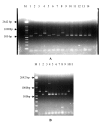Characterization of Pseudomonas aeruginosa isolated from chronically infected children with cystic fibrosis in India
- PMID: 16033658
- PMCID: PMC1183212
- DOI: 10.1186/1471-2180-5-43
Characterization of Pseudomonas aeruginosa isolated from chronically infected children with cystic fibrosis in India
Abstract
Background: Pseudomonas aeruginosa is the leading cause of morbidity and mortality in patients with cystic fibrosis (CF). With chronicity of infection, the organism resides as a biofilm, shows multi-drug resistance, diversifies its colony morphology and becomes auxotrophic. The patients have been found to be colonized with multiple genotypes. The present work was carried out to characterize P. aeruginosa isolated from children with cystic fibrosis using phenotypic and genotypic methods.
Results: We studied 56 patients with CF attending the Pediatric Chest clinic at All India Institute of Medical Sciences, New Delhi, India during August 1998-August 2001. These patients were regularly followed up at the clinic. Out of 56 patients, 27 were culture positive for P. aeruginosa where 8 were chronically infected (Group1) and 19 were intermittently colonized with the organism (Group2). Patients under Group1 had significantly higher rates of hospitalization, death and colonization with different colony morphotypes (p < 0.05). The isolates from Group1 patients were the positive producers of extended spectrum beta lactamase. A total of 5 auxotrophs were recovered from 2 patients where one was chronically infected with P. aeruginosa and the other was a recently enrolled patient. The auxotrophs had the specific requirement for methionine and arginine. Molecular typing revealed 33 ERIC-PCR (E1-E33) and 5 PCR-ribotyping (P1-P5) patterns. By ERIC-PCR, 4 patients were colonized with 2-4 genotypes and the remaining 23 patients were colonized with the single genotype.
Conclusion: With chronicity of infection, P. aeruginosa becomes multidrug resistant, diversifies its colony morphology, acquires mucoidity and shows auxotrophy for amino acids. The chronically infected patients can be colonized with multiple genotypes. Thus in a particular clinical set up, high index of suspicion should be there for diagnosis of CF patients so as to prevent the delay in diagnosis and management of CF patients.
Figures




Similar articles
-
Phenotypic & genotypic variants of Pseudomonas aeruginosa isolated from children with cystic fibrosis in India.Indian J Med Res. 2002 Aug;116:73-81. Indian J Med Res. 2002. PMID: 12592994
-
Diversity of β-lactam resistance mechanisms in cystic fibrosis isolates of Pseudomonas aeruginosa: a French multicentre study.J Antimicrob Chemother. 2013 Aug;68(8):1763-71. doi: 10.1093/jac/dkt115. Epub 2013 Apr 29. J Antimicrob Chemother. 2013. PMID: 23629014
-
Characterization by phenotypic and genotypic methods of metallo-β-lactamase-producing Pseudomonas aeruginosa isolated from patients with cystic fibrosis.Mol Med Rep. 2015 Jan;11(1):494-8. doi: 10.3892/mmr.2014.2685. Epub 2014 Oct 16. Mol Med Rep. 2015. PMID: 25323940
-
Infections with Pseudomonas aeruginosa in patients with cystic fibrosis.Behring Inst Mitt. 1997 Feb;(98):249-55. Behring Inst Mitt. 1997. PMID: 9382747 Review.
-
Early eradication of Pseudomonas aeruginosa in patients with cystic fibrosis.Paediatr Respir Rev. 2010 Sep;11(3):177-84. doi: 10.1016/j.prrv.2010.05.003. Epub 2010 Jun 16. Paediatr Respir Rev. 2010. PMID: 20692633 Free PMC article. Review.
Cited by
-
VEB-1 in Achromobacter xylosoxidans from cystic fibrosis patient, France.Emerg Infect Dis. 2006 Nov;12(11):1737-9. doi: 10.3201/eid1211.060143. Emerg Infect Dis. 2006. PMID: 17283625 Free PMC article.
-
Twenty-five-year outbreak of Pseudomonas aeruginosa infecting individuals with cystic fibrosis: identification of the prairie epidemic strain.J Clin Microbiol. 2014 Apr;52(4):1127-35. doi: 10.1128/JCM.03218-13. Epub 2014 Jan 22. J Clin Microbiol. 2014. PMID: 24452167 Free PMC article.
-
Hidden risks of biofilm-forming and multidrug-resistant Gram-negative bacteria in water vending machines.Antonie Van Leeuwenhoek. 2025 Aug 13;118(9):128. doi: 10.1007/s10482-025-02142-4. Antonie Van Leeuwenhoek. 2025. PMID: 40801958
-
Pseudomonas aeruginosa syntrophy in chronically colonized airways of cystic fibrosis patients.Antimicrob Agents Chemother. 2012 Nov;56(11):5971-81. doi: 10.1128/AAC.01371-12. Epub 2012 Sep 10. Antimicrob Agents Chemother. 2012. PMID: 22964251 Free PMC article.
-
Available evidence of antibiotic resistance from extended-spectrum β-lactamase-producing Enterobacteriaceae in paediatric patients in 20 countries: a systematic review and meta-analysis.Bull World Health Organ. 2019 Jul 1;97(7):486-501B. doi: 10.2471/BLT.18.225698. Epub 2019 May 14. Bull World Health Organ. 2019. PMID: 31258218 Free PMC article.
References
-
- Ahuja AS, Kabra SK. Cystic fibrosis: Indian experience. Ind Pediatr. 2002;39:813–818. - PubMed
-
- Singh M, Prasad R, Kumar L. Cystic fibrosis in north Indian children. Ind J Pediatr. 2002;69:627–629. - PubMed
-
- Kabra SK, Kabra M, Lodha R, Shastri S, Ghosh M, pandey RM, Kapil A, Aggarwal G, Kapoor V. Clinical profile and frequency of delta 508 mutation in Indian children with cystic fibrosis. Ind Pediatr. 2003;40:612–619. - PubMed
Publication types
MeSH terms
LinkOut - more resources
Full Text Sources
Medical
Miscellaneous

